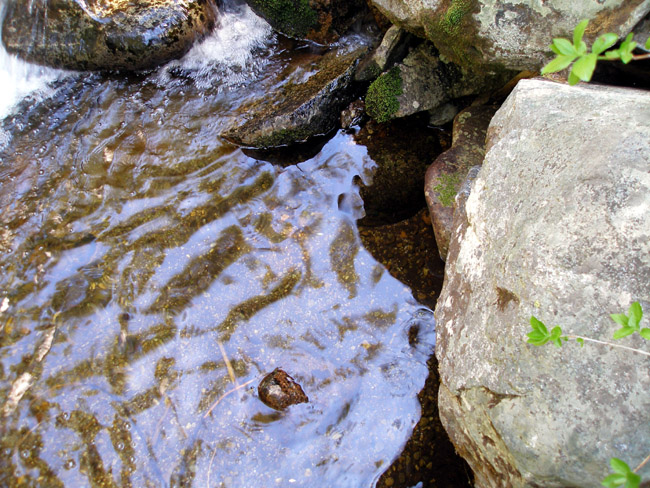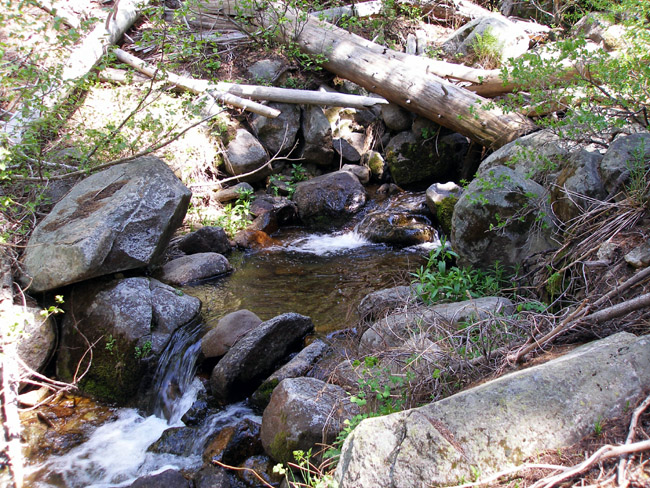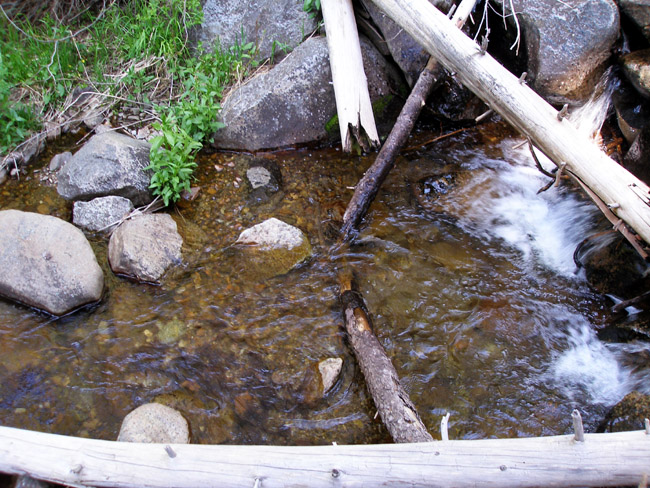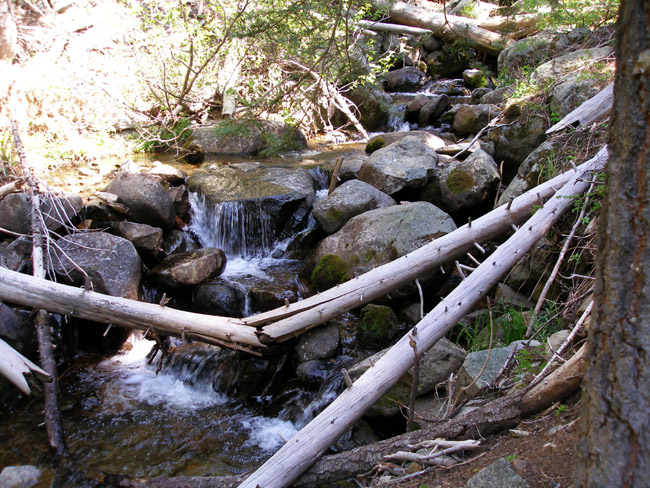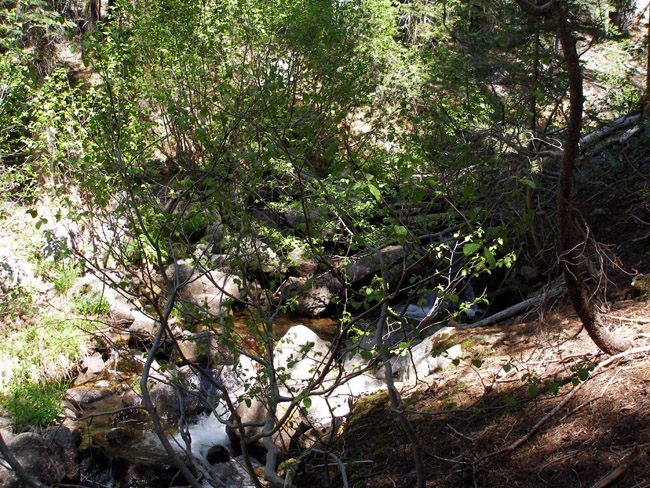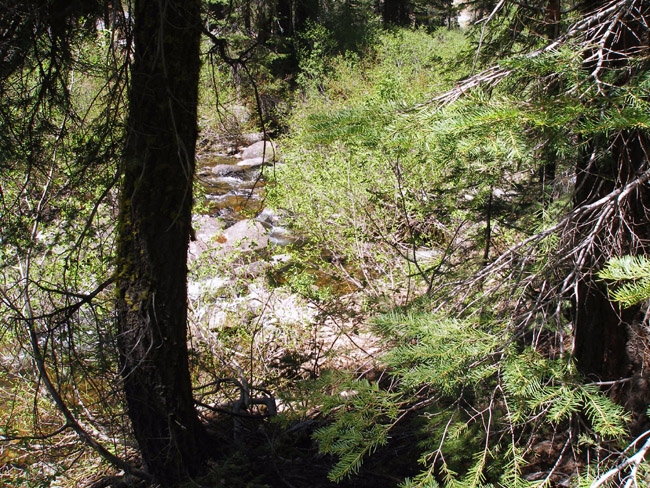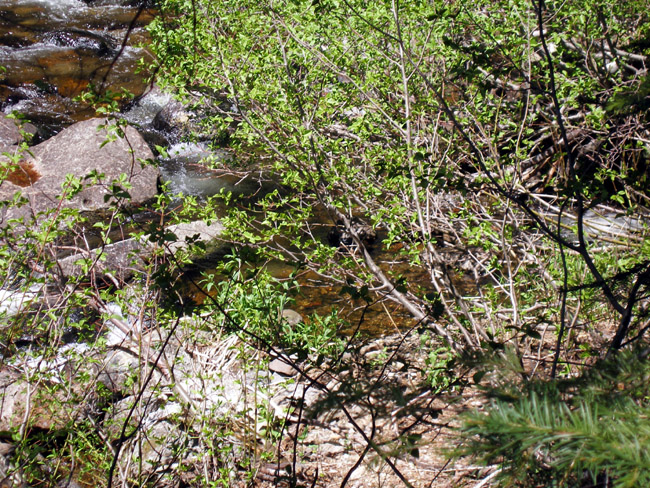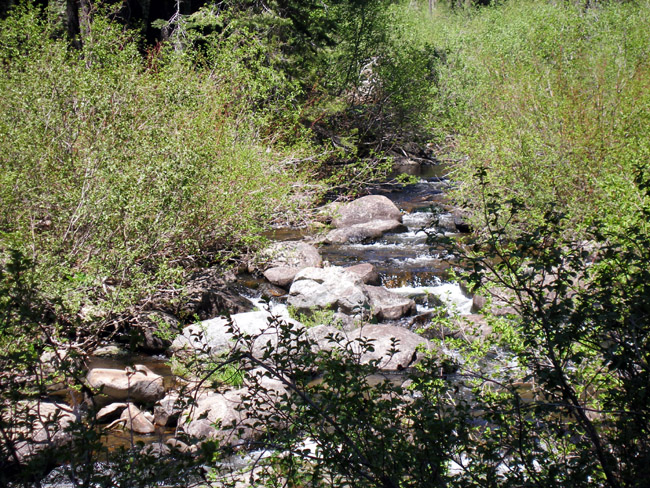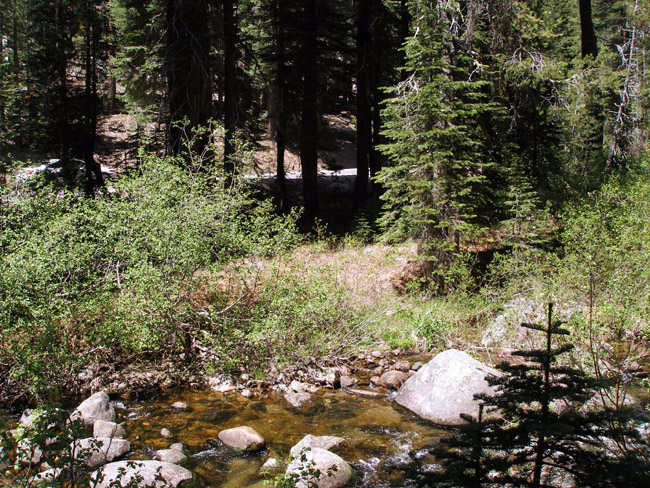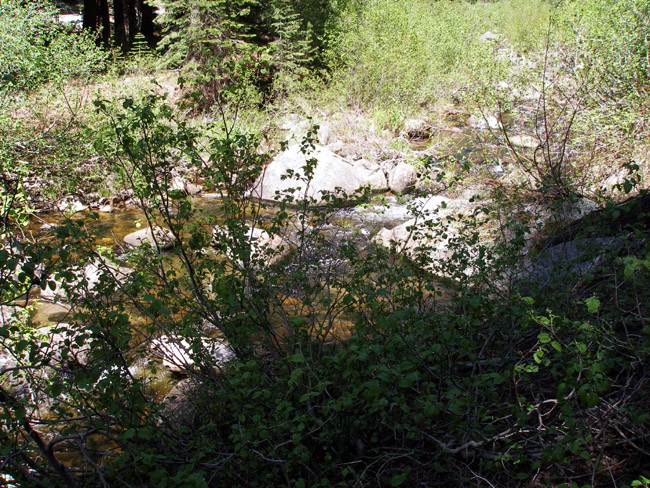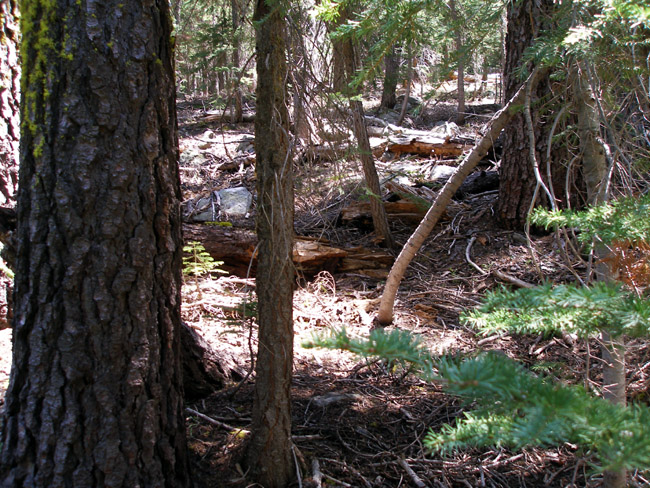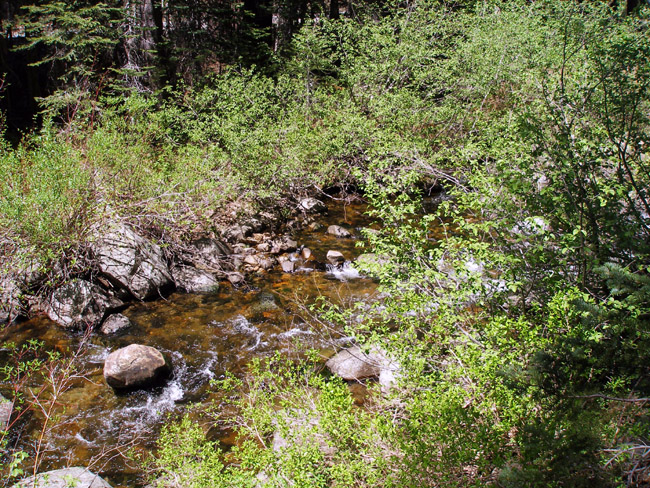There are some nice air-breaks and drops in the upper part of this photo, just below the ripples. You’d look for bedrock, of course, but first, you’ll want to find the exact water-break where the floodwater allows the gold to drop straight down through an air pocket. Gold wants to fall first, and will be ahead of all the other heavy minerals, slightly upstream from the sand, where the gravel falls and the heavier metals will be found.
The second small falls (actually sort of a lightweight rapids) has a nice break and might in floodwater still provide a good drop point, so I’d check it out without disturbing the rocks that make up the break. You want it to be here next year, too. The Skilled Miner (sort of like the Perfected Person in the I-Ching, eh?) will have no problem leaving the ground intact while checking for gold at the bedrock level. It furthers one to cross the great river, as they say.
Boy, this spot cries out for a drawpipe, don’t it? But what I’d probably do here is look for floodwash and high-bank it about ten feet from the river’s edge, maybe up to about forty feet if it looked like highbanker country, and to me, it sure does. You’ll want to check the moss first, of course, to see if anything got over the spring and summer banks, and you can bet some did.
If this area isn’t loaded with gold, it’s an exception. Of course, the depth of bedrock will determine whether you can actually get at it or not, and you can’t destroy the river to do it — you’ll have to ease your way through this, and in order to leave the riverbed in good shape, you’ll need a 3′ or 4′ sucker to draw the stuff up from below.
You can see the high-banks from here. That’s where you’ll do most of your prospecting, if you’re smart, although the riverbed can offer some tempting large-nugget treats, if you know exactly where to look and how to find them, but most folks actually toss them out of their pan, right back into the river…
You can have the rest of the river — give me this section of stream to work and I will come up with around 3 grams an hour. I know that’s not great, but it’s not bad. Once I find the “sweet spots”, I can take out a lot more, but it’s hard work, and you can’t fake that. Gold prospecting is not for the lazy. You can’t just wait for the gold to jump into your collecting jar.
This little pool is a natural “break”, and will contain some gold — how much you can get out of this hole will depend on how far down you have to go to hit bedrock. There are going to be great placer deposits all around this area if you can manage to pinpoint them, which I do by simple walkover-dowsing, no rod, just sensing for small localized deposits. Of course, you can also use a metal detector, the smaller the coil, the better. I’d be using a 2″ flat-coil, with the settings at beeping “gold”, nulling “iron”, sensitivity at the highest level I can find relative to the background (you should rebalance your coils every time you use the detector, to find the local ground “noise”, which you need to null before trying to detect field-anomalies. You can’t find something odd if you don’t first measure the background and subtract that from your readings — just like you do with tarot readings; subtract the obvious, and cut to chase.
This little downhill run looks quite placid in late spring and summer, but in floodwaters, it’s going to be a terrific riffle box, trapping plenty of gold in the drop areas on the downstream side of the rocks. Don’t forget that this whole thing is underwater during the spring runoff, when the snow melts, so the breaks are actually higher and slightly upstream from what they look like by the time you’re ready to get up there to 6,000 feet of elevation, just below the Great Mother Lode — you can’t get much closer to it, but the cost of getting a spot near the Mother Lode is that you’re going to be at a bit of elevation, because that’s where the gold mostly is. By the time it trickles down to Nevada City, it’s been picked over by thousands of miners, and found niches in millions of spots along the way. Sutter’s Mill (Actually Sutter Mills) is a profound exception. Most of the gold is found upstream, except that NONE is found above the Mother Lode. The Lode is where it washes into the river, and nowhere else.
What an ideal spot to set up a small campsite, where you can pan to your heart’s content all day long! This is going to be a noob’s delight, because there’s plenty of gold here to be found, but not enough to satisfy the average goldminer — you might, if you’re lucky, pull out 1-3 grams a day, anywhere from $50-$150 a day. Most folks will end up spilling more than they take out, so it pays to learn really well before blowing territory — you can’t work it again until next year’s runoff, see???
Right here in front of your eyes is a whole summer’s work, if you’re careful and know enough to work this spot. It’s got gold aplenty, but you have to know how to find it and get it out of the ground. Most of this will be microfines at about .600 to .800 microns, stuff you can’t see except in quantity, and it’s mighty hard to recover, even with special engineering knowledge. We have that knowledge, and we recover about 99% of the gold that’s actually there. We have ways of testing our recovery rate, which you will learn fast, when you’ve lost an ounce or two and realize it’s gone down the drain. Ignorance is NOT bliss, no matter what you’ve been led to believe.
This is a great area to muck about in, but the gold has already gone far down into the ground, into deep crevices in the bedrock and lava bed, long ago, and far, far below. Anything running off now would be quickly lost into the ground — gold falls through earth almost as rapidly as it does through water and air. It literally dives down and keeps going until stopped by bedrock.
Aha, so obviously any bedrock that lies exposed would be a tempting place to look for gold, if it hadn’t been for 150 years of miners picking over the place long before you ever got here. However, the good news is that when the price of gold sits for a century at $11-$35 an ounce, a few crumbs weren’t worth picking at. Today, at around $1200-$1300 an ounce, even the smallest crumb wouldn’t be smart to overlook, so we try to find what the previous miners left behind as not worth bothering with, and there’s plenty of that.
You won’t find The Big Nugget out here — well, the fact is that you just might, but the odds are against you, but not totally so. You just might find a 5 ounce nugget. One of our folks back in Meadow Vista days found one in the North Fork of the American River. But boy, is that ever the oddball — it just doesn’t happen often enough to pay down a 30-year mortgage. But the little microfines add up fast, and from them you can make a living.
Every single rock formation you see here can hold gold if the river current is just right, which happens at the end of the spring runoff. Most of the larger chunks are crushed below, but at this elevation, the gold is raw and sharp, just having spewed out of the Mother Lode, which is being slowly eroded, spilling metals and gemstones into the riverbed and surrounding banks, when they are flooded.
The whole thing, all the way down to the Sacramento River, is an ancient Flood Plain, and you actually have to pay insurance that reflects that fact. This makes it a great Placer Gold site — everything west of the Sierras — which means that the gold is on the surface as well as in deep ground deposits at around 500-1500 feet underground. We’re after only the surface gold.
Well, that’s a short tour of our Prosperity Gold Mine. We’ll add to it as other areas get photographed. I hope you’ll be able to join us for this summer’s gold prospecting adventure, starting June 12th!
It’s free, you get to keep 60% of the gold you keep and donate 40% to the Institute to help pay for this great work opportunity! You can work for yourself and at the same time support the Gold Claim and its development. We’re talking about the possibility of leasing BLM land as an Ashram Campground until we have the funds to buy a campground outright. We’ll keep you posted on developments.
See You At The Top!!!
gorby


